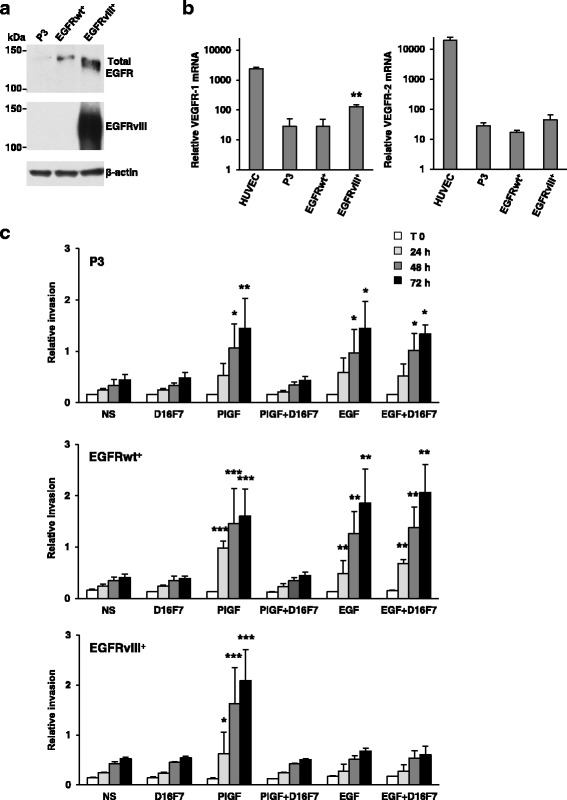Fig. 3.

D16F7 inhibits ECM invasion of P3, EGFRwt+ and EGFRvIII+ GSCs that express VEGFR-1. a EGFR or mutated EGFRvIII protein levels were analyzed by Western blotting using β-actin detection as loading control. b Detection of VEGFR-1 and VEGFR-2 transcripts was performed by qRT-PCR. Results indicate relative mRNA expression and are the mean ± SD of three independent determinations. EGFRvIII+ vs P3 and EGFRwt+ cells, p < 0.01 (**). c For spheroid invasion assay cells were embedded in matrigel in the absence or presence of D16F7 (10 μg/ml) and PlGF or EGF. Data are the mean ± SD (n = 5–10) relative invasion evaluated as described in Fig. 1d legend. Results of statistical analysis using one-way ANOVA, followed by Bonferroni’s post-test were as follows: in P3 cells PlGF vs NS, PlGF vs D16F7 or PlGF vs PlGF + D16F7, p < 0.05 (*) at 48 h and p < 0.01 (**) at 72 h; in EGFRwt+ cells PlGF vs NS, PlGF vs D16F7 or PlGF vs PlGF + D16F7, p < 0.001 (***) at 24, 48 and 72 h; in EGFRvIII+ cells PlGF vs NS, PlGF vs D16F7 or PlGF vs PlGF + D16F7, p < 0.05 (*) at 24 h and p < 0.001 (***) at 48 and 72 h. In all cell lines differences between NS and D16F7 or PlGF + D16F7 or between EGF and EGF + D16F7 were not significant. In P3 cells, EGF vs NS or EGF + D16F7 vs NS, p < 0.05 (*) at 48 and 72 h; in EGFRwt+ cells, EGF vs NS or EGF + D16F7 vs NS, p < 0.01 (**) at all time points
